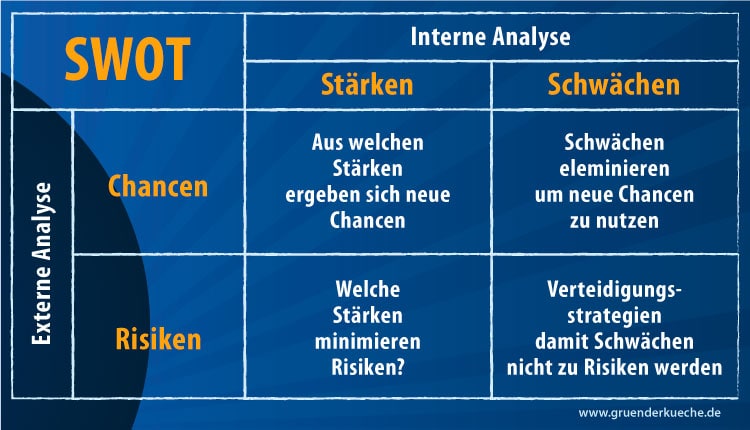Know your strengths and weaknesses to recognize opportunities and risks: the SWOT analysis is a proven tool for developing the strategy of companies.
For start-ups and founders in particular, it's a good opportunity to determine at an early stage with which company orientation you have the greatest chance of success in the market Have.
A detailed SWOT analysis is crucial for startups: on the one hand to determine their future market position, on the other hand to convince investors. Because banks and investors attach great importance to you creating your SWOT analysis thoroughly and conscientiously. Critical examination of the market and competitive situation should be an essential part of your business plan.
You can find out exactly what a SWOT analysis is, how it works and when it makes sense to use it in our specialized article.
What is SWOT Analysis?
Strengths, weaknesses, opportunities and threats: SWOT is an acronym and stands for
- St = Strengths (Strengthen)
- w = weaknesses (weaknesses)
- OR = opportunity (opportunity)
- T = threat (risks)
A SWOT analysis is one at the same time an internal business analysis and an external competitor analysis. You can find out by relatively simple means,
- where your company has advantages over competitors,
- where your company has disadvantages compared to competitors,
- what opportunities and challenges your specific market environment has.
How to use SWOT analysis? An example
S (strengths) describe the (internal) strengths of a company. This could be, for example, a carpentry shop that produces a shelf at a particularly low price or shelves that are highly flexible – for example via an online configurator – to individual customer needs
can customize.
W (weak points) The weaknesses of the company could be, for example, not being able to react to new trends. To continue the SWOT analysis using the example of carpentry: despite the green trend, the company still does not offer shelves made from sustainably produced wood. Weaknesses don't necessarily have to be something bad.
Or (opportunity) External circumstances, such as new demand or strong market growth for sustainably produced wood shelving, can present an opportunity. The carpentry shop can adapt or expand its business model. It is important to list all opportunities comprehensively in order to be able to plan the market strategy as comprehensively as possible. With the SWOT approach, both strengths and weaknesses can be opportunities.
T (Threats) Of course, every strength and weakness of a company also harbors a certain risk in the market. For example, the woodworking shop may be in financial difficulty because it needs to purchase new machines to convert production. Also, it might
Customers are put off by the higher prices for shelves made from sustainably produced wood or the green trend fades away.
SWOT analysis – you need it for this
SWOT analysis is an inventory, it describes the current situation. Only in the next stage will you process these findings to develop a viable concept for your start-up. For this it is important that you honestly evaluate your strengths and weaknesses and name them constantly, and ultimately create a solid basis for positioning your company with the objective assessment of opportunities and risks.
SWOT analysis helps you to define a strategy for your company and to use your resources correctly. You can only initiate significant projects and take steps that will move your business forward if you know exactly what the current situation is.
This method also helps if you plan to expand your offering. SWOT analysis can be used excellently for new products.
TIP: Here we have one selection of The best free tools for the business plan.
Create a SWOT analysis for the business plan: how to do it
SWOT analysis is an extremely important part of your business plan. Know your strengths and market opportunities, but also know your weaknesses and risks in your field of activity. When it comes to this, you should not only see your company's strengths as opportunities, but also the weaknesses: because there is great potential here to adapt and/or refine your business idea. This can be very important, especially for startups, in order to determine their future market position.
It is also important to clearly distinguish between strengths and opportunities in the market – not all strengths are actually usable opportunities or advantages. Here, errors in the company's positioning often occur.
With a precise SWOT analysis, you have all important data about your foundation and your market at a glance in the business plan. This not only pleases investors, but is an important tool for you. Then SWOT analysis helps you think and develop your business plan with the necessary completeness. You can develop a strategy to achieve your business goals and name the necessary tools (marketing, HR, success control).
Instructions SWOT Analysis: Step by step implementation
Since SWOT analysis describes the current situation, you have to do a lot of research first. After all, you first want to get an idea of what the market you want to enter with your start-up looks like. It only works if you have all the relevant data and facts ready. So you need to know who your competitors are, what special features there are in your industry (e.g. mandatory foreman, legal regulations), what needs customers have and whether there are any social or economic peculiarities to consider.
Step 1: Gather information
The most important basis is valid information about your business, the market, competitors and your product.
Who are your competitors?
Who are your prospects turning to so far? Where else could they go? Who offers similar products alongside direct competition.
List of your competitors
Make a list of your competitors, narrowing it down to the most important ones. The market leader in your industry and your fiercest competitors should be represented.
Where do you get the data from?
Depending on your business idea, you can use the Internet, market analysis, expert discussions and/or on-site research for your research. The following sources are a good addition so that you can get the full picture:
- Corporate directories (e.g. Yellow Pages)
- Industry reports from associations
- Reports from market research firms, some of which are published free of charge
- Websites and press releases of each company
- Test reports (Here you can find out what other suppliers have solved well, what problems there are and what customers appreciate.)
Internal analysis: what is important for your company and your products? Offering, pricing, marketing, distinctive features, strengths and weaknesses – the features you include in your research will depend on the nature of your business. The following factors may be of interest:
- Offer/products: special features/unique selling points, prices, quality, design
- marketing
- Customers: location, target groups, sales channels, opening hours, service
- Company: Strategic orientation, suppliers, networks, company management, employees, image, process efficiency
- Financial strength: external capital, debt
Of course, this list is not comprehensive, nor is it necessary to elaborate on all points. Rather, it is important to consider in advance which focal points you want to set that are relevant to your business.
Step 2: Simple SWOT Analysis (with Template)
It is now necessary to view and evaluate the information collected. A template for SWOT analysis can be found here:
Alternatively, you can also divide a piece of paper into four equal squares, one for each:
- strengths (S(strengths)
- the weak points W(defects)
- the possibilities O(opportunity)
- the risks T(threats)
First, you honestly and objectively analyze which of the information gleaned from internal analysis represents the potential (strengths) and deficits (weaknesses) of your business model. For example, you can find out if you have unique selling propositions, what you can do better than your competition, and where your competition is ahead. And this in turn means that you can set your focus and priorities very clearly. And don't get bogged down with side yards.
From this you can then derive the opportunities and risks (external analysis) of your business model. You have a good overview of what strategies your competitors are pursuing and which market niches are big enough for you. In addition, assign the particularities of your industry (e.g.: master craftsman duty) and external trends (e.g.: ecological trend, market development) to one of the two fields.
3rd stage: complete assessment with the SWOT matrix
In the next step, the results of the internal analysis are assigned to the results of the external analysis in the SWOT matrix. The best way to do this is to use this template:

Here you can clearly see the connections between your strengths and weaknesses on the one hand and the opportunities and risks on the other. With the evaluation of the SWOT matrix you can develop the right strategies for your business projects. The combination of strengths, weaknesses, opportunities and threats result in four basic approaches:
Use the advantage (strengths-opportunities-strategy)
Here you can see with which internal strengths you can optimally use which existing opportunities on the market to expand your business and exploit your (growth) potential.
Gaining ground (weakness-opportunity strategy)
Get an overview of which internal weaknesses prevent you from exploiting existing opportunities. You can see where you have room for improvement to catch up (compared to the competition).
Keep Your Distance (Strength-Threat Strategy)
With your internal strengths you can minimize the risks in the market and ward off dangers. You know how you can secure your market position.
Avoiding dangers (risk-weakness strategy)
Here you can see which internal weaknesses become a risk for your company. But it also lets you know what actions you need to take to avoid threats.
CONCLUSION: Use SWOT analysis correctly
Although the SWOT analysis should be part of every business plan: It is not only useful for companies that still want to gain a foothold in the market, but for any company that wants to develop a successful marketing strategy or adapt an existing one. Regardless of industry or company size, it's crucial that your ind knows your individual strengths and weaknesses and can derive opportunities and risks for your business model.
SWOT analysis is a representation of opportunities and threats. If you want to analyze and visualize your business model in more detail, you should Business model canvas look at.
Are you currently working on your business plan? Free tools help you create: THE best business plan tools we collected and tested.

